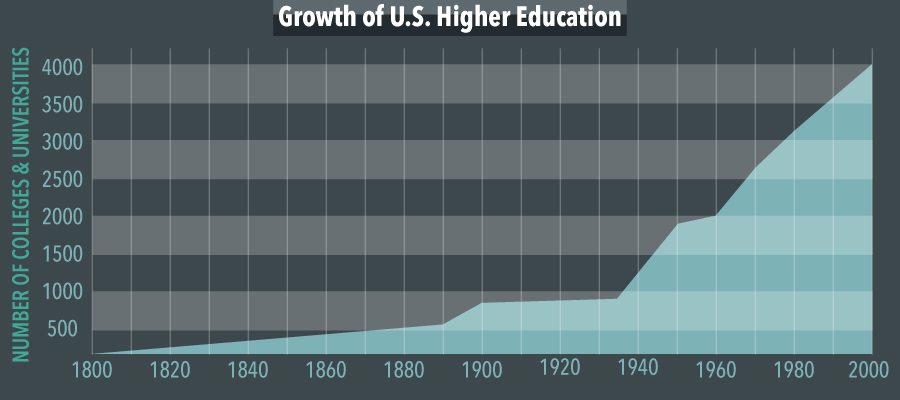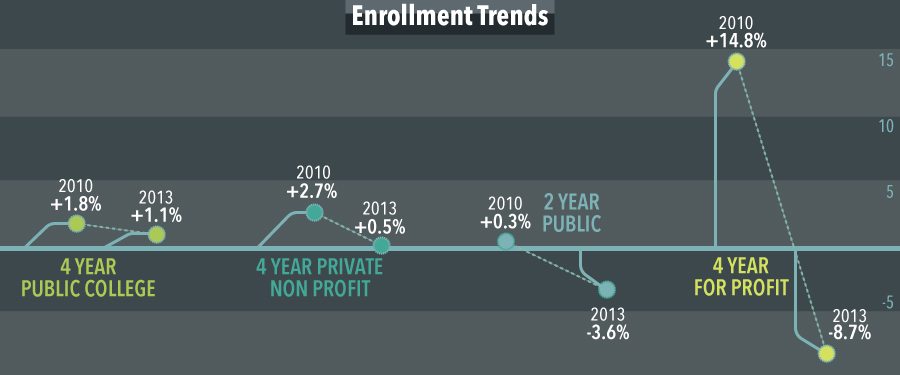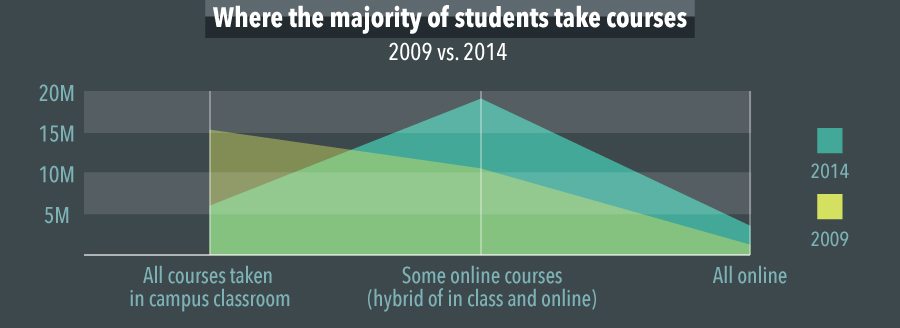The Changing Landscape of Higher Education
Updated May 3, 2021 | Staff Writers
Search Programs
Changing Landscape of Higher Education
Imagine if George Washington could step into a time machine and find himself in modern day America. He surely wouldn’t recognize the educational landscapes that now exist in all the colleges and Universities named after him.
[Tweet "Many universities, including the Ivy League, entered the online learning space in 2012"]
In Washington’s time, the first American colleges were established by religious groups to foster the faith. They offered a broad liberal arts curriculum designed to educate young Puritan ministers. But as college education grew more and more relevant to worldly life, the traditional liberal arts gave way to science and vocational training.
Example: Harvard University, the oldest university in the U.S., graduated about 70% clergymen in the 17th century, 45% in the 18th, and by the end of the 19th century, only 10%.
The Shift in American Education
The shift toward secular, practical education was inevitable. Thomas Jefferson was an early advocate of expanded higher education opportunities. He argued that America's growing democracy needed an educated citizenry and that the growing market economy needed a skilled workforce. Abraham Lincoln agreed, and signed the Morrill Land-Grant Act pledging to "donate Public Lands to the several States and Territories which may provide Colleges for the Benefit of Agriculture and Mechanic Arts."

Everything changed with the recession of 2008-2011, as the world’s feeble economic recovery altered the landscape of higher education and posed a complex challenge for smaller colleges, as they now struggle to survive.
Flat or falling net-tuition revenues are likely to worsen the problems colleges already face, especially private institutions that have contained expenses for multiple years, including limited, if any, compensation increases, delayed capital investment, and reductions to programs and services. Many colleges may feel the need to make strategic investments in people and programs to remain competitive, but these expense increases will likely outpace the growth of student charges, resulting in a growing number of colleges with operating deficits.
Is College Worth the Investment?
Students, and their parents, are also demanding a return on their investment. It is not just academic quality and prestige that prospective students look for today; they also demand a proven track record of graduate school admissions, job placements and earning potential in relation to the overall cost of enrollment.
Issues including affordability, soaring student (and campus) debt, and shrinking state and federal funding are raising very real questions about the sustainability of the current higher education business model. These trends are especially profound on regional public universities and smaller private colleges lacking a well-defined niche. What follows are enrollment trends over a three year period… 2010 to 2013. As you can see, not a good sign for educational institutions.

Colleges, both large and small, are facing up to this challenge. Education is in the midst of a digital revolution. Universities, large and small, have embraced new class formats and technologies designed to meet evolving student needs and cut costs. Course schedules were redesigned for affordability.
Example: since 2011 Wesleyan University has a condensed schedule to enable students to complete their education in three years. Others moved courses online or began using technology-based instruction for large, introductory courses.
Enter the Ivy League... and Everyone Else
Many universities, including the Ivy League, entered the online learning space in 2012, either building their own online ventures or partnering with an existing provider, such as Coursera and Udacity. Coursera, founded by two Stanford University professors, offers massive open online courses (MOOCs) through partner universities, including Caltech, Duke, Georgia Tech, Johns Hopkins, Michigan, Penn, Princeton, Stanford, University of Virginia and many others.
Smaller players, too, have gone digital. A consortium of 16 liberal arts colleges and universities in the South began the New Paradigm Initiative in 2012, offering online and blended courses open to students at any school within the consortium.
Universities are also becoming savvier about using data tools, such as data analytics or mining, in order to guide students and support decision-making.

By 2020, the landscape of higher education in the U.S. will look very different. The old hierarchical, geographically based university is dying. And that may help smaller universities survive. There will still be bricks-and-mortar residential campuses, but classes will be hybridized (i.e., a combination of online and in-class instruction). Instructors, using rapidly maturing technologies, will no longer need to rely on in class lectures as the predominant mode of instruction; rather, group and individual project-based learning will be the pedagogical norm.
[Tweet "The old hierarchical, geographically based university is dying."]
Looking Forward: Blended Instruction
A future college model might look like this: Courses with blended online and land-based, or in some cases fully online instruction, using technology to expand access and reduce costs; courses with far larger enrollments, leveraging technology; limited and flexible physical plants, with more leasing than owning; flexible hiring, with reasonable compensation and the ability to increase and decrease skill sets; teaching and student learning are prioritized; and streamlined student and administrative services.